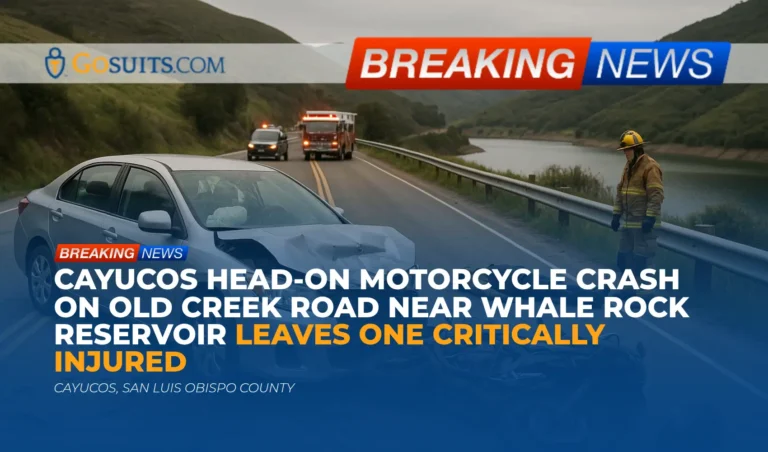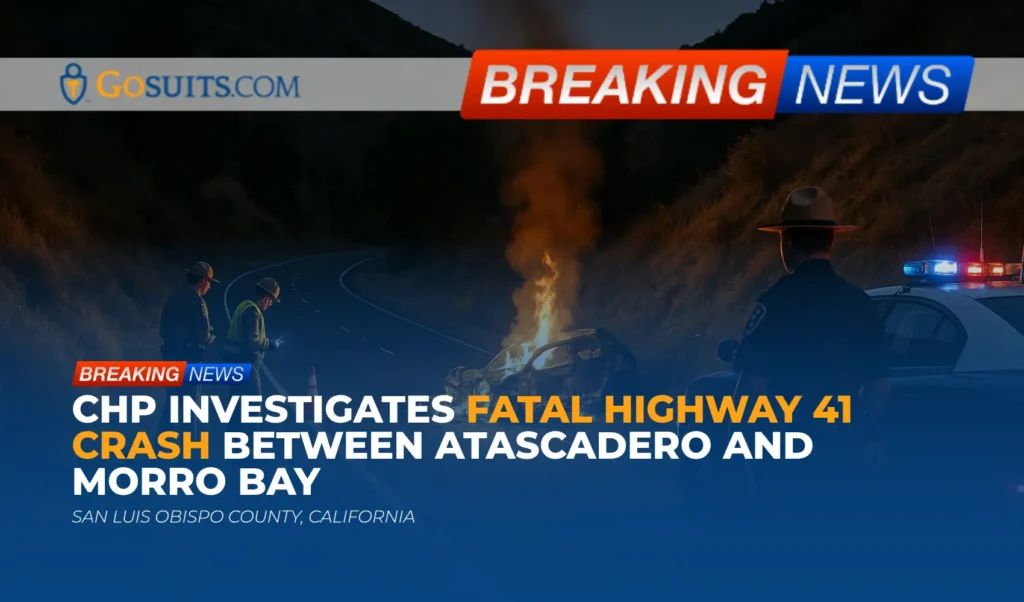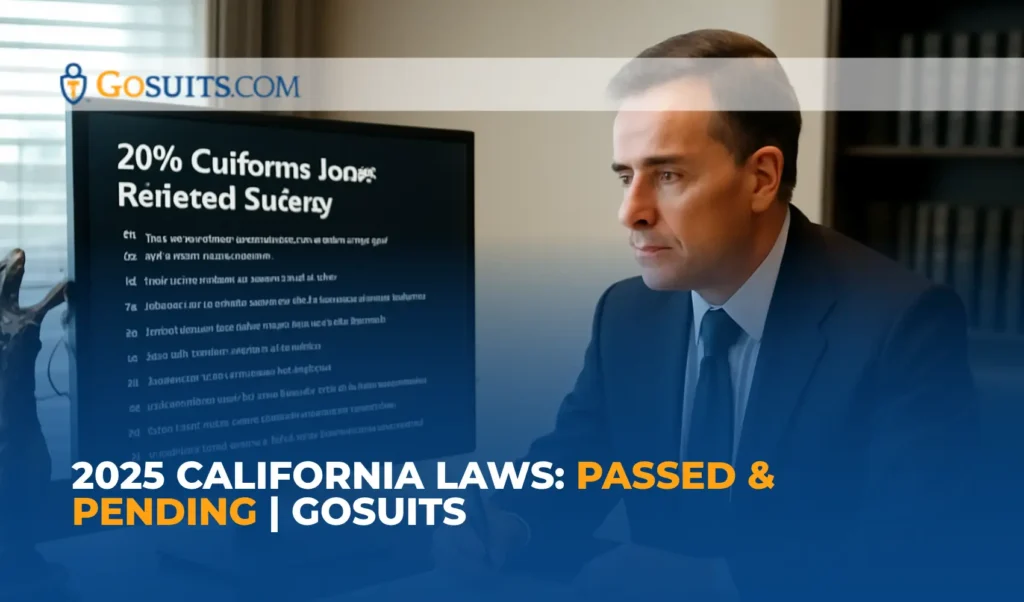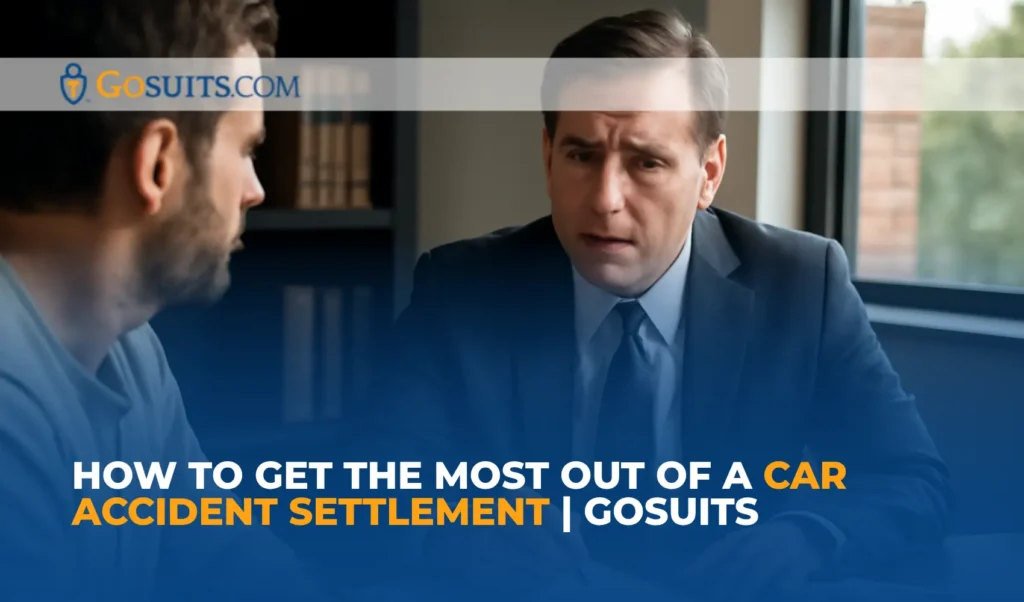- What we know about the Old Creek Road motorcycle crash near Whale Rock Reservoir
- Understanding the location: Old Creek Road and Whale Rock Reservoir in Cayucos
- Immediate next steps for those affected
- How to obtain official records: collision reports, coroner documents, and medical records
- Potential civil liability in a head-on motorcycle collision
- Insurance considerations after a motorcycle-vehicle crash in California
- Common injuries in head-on motorcycle collisions and why urgency matters
- Preserving evidence and documenting losses
- Reporting and timelines required under California law
- Traffic updates and roadway safety resources
- Commentary from Gosuits Cayucos, California Personal Injury Attorney
- Call-to-action: Why timely action matters and practical steps to take
What we know about the Old Creek Road motorcycle crash near Whale Rock Reservoir
A head-on collision involving a Toyota sedan and at least one motorcycle occurred on Old Creek Road near the Whale Rock Reservoir, in the Cayucos area of San Luis Obispo County. The crash was reported at approximately 3:25 p.m. Initial emergency radio traffic indicated serious injuries at the scene, and subsequent reporting described one person as critically injured. The California Highway Patrol (CHP) incident log reflected that there were traffic hazards in both lanes and suggested the possibility that a second motorcycle might have been involved. At the scene, firefighters worked to remove debris and the CHP conducted measurements, a routine part of collision investigation. Tow trucks were requested for both the motorcycle, described as having major damage, and the Toyota sedan. Cell service was reportedly unavailable at the scene, which can delay calls for help and coordination.
Because this is a developing situation, details may be refined as the investigation progresses and as official records are completed. The CHP will typically document statements, scene measurements, and physical evidence in a collision report that can be requested by involved parties later.
Understanding the location: Old Creek Road and Whale Rock Reservoir in Cayucos
Old Creek Road winds through the coastal hills east of Cayucos and near the Whale Rock Reservoir. This roadway includes curves, changes in elevation, and stretches with limited pullouts. In rural segments, wireless coverage can be inconsistent. When a serious crash occurs in an area with weak or no cellular signal, bystanders may need to drive to higher ground or a nearby area with reception to reach 911, or flag down passing motorists for assistance. Responders typically include CHP, local fire agencies, and EMS transport units. Road closures or one-way traffic control are common as debris is cleared and measurements are taken. Those efforts are intended to protect responders and preserve evidence while reopening the roadway as quickly as possible.
Immediate next steps for those affected
After a crash of this severity, the priorities are health, safety, and preserving essential information. The following general steps are offered with care for those involved and their loved ones:
- Seek and follow medical care: Even when injuries seem manageable, motorcycle crashes can cause internal trauma that is not immediately obvious. Follow through with emergency care, diagnostic imaging, and the treatment plan recommended by clinicians.
- Preserve evidence early: If possible, safely photograph the vehicles, roadway, skid marks, debris fields, and any relevant signage or road conditions. Save helmet and riding gear, as damage patterns can matter in evaluating forces and injury mechanisms. If you cannot do this yourself, a trusted person may help.
- Identify witnesses: Record names, phone numbers, and brief statements from anyone who saw the collision or its aftermath. In areas with poor cell coverage, written notes made at the time can be especially valuable.
- Do not rush to provide recorded statements to insurers: Insurance representatives may contact people quickly. Consider speaking with a qualified attorney first to understand rights and obligations, as statements can be used by insurers later.
- Keep all receipts and records: Hospital invoices, prescriptions, time missed from work, and transportation costs help document losses.
How to obtain official records: collision reports, coroner documents, and medical records
CHP collision report for Old Creek Road
CHP completes an official collision report documenting parties, vehicles, injuries, roadway conditions, diagrams, and contributing factors. Involved individuals or their legal representatives can request a copy once it is finalized.
- How to request: CHP uses Form CHP 190 (Application for Release of Information) for collision reports. The form and instructions are available through CHP’s records page. See CHP Collision Reports and the request form CHP 190.
- Which office: Requests are typically handled by the local Area Office that investigated the crash. If you are unsure which office covers Old Creek Road near Cayucos, CHP’s office locator can help: Find a CHP Office.
- What you may need: Date and location of the crash, names of involved parties, and your role (e.g., involved driver, injured party, parent/guardian, or authorized representative). There may be a copying fee.
Coroner records in San Luis Obispo County
If a collision results in a fatality, the Sheriff-Coroner is responsible for the death investigation and related records, which may include a coroner’s report, autopsy findings, and toxicology (when performed). In San Luis Obispo County, the Sheriff-Coroner functions within county government.
- Where to start: Visit San Luis Obispo County’s government site and navigate to the Sheriff-Coroner pages: slocounty.ca.gov. The Sheriff-Coroner’s section includes contact information and procedures for requesting records.
- What to expect: Depending on the case, final reports can take weeks to months. Next-of-kin usually have priority access. Some materials may be limited or redacted by law.
- Why it matters: Coroner findings can be important for understanding cause and manner of death, injury mechanisms, and timing, which can be relevant to insurance claims and civil wrongful death actions.
Medical records for injury documentation
Hospitals and clinics maintain diagnostic imaging, physician notes, surgical reports, and discharge summaries that are central to demonstrating injury severity, treatment, and prognosis. Federal rules protect your right to access your records within a reasonable timeframe.
- Your right to access: The U.S. Department of Health and Human Services provides guidance on obtaining copies of your medical records. See HHS: Your Right to Access Health Records.
- What to request: Emergency department records, imaging (X-ray, CT, MRI), operative notes, consultation reports, physical therapy notes, and billing statements. Request records in both readable and diagnostic image formats when appropriate.
Potential civil liability in a head-on motorcycle collision
Determining civil responsibility in a head-on crash is fact-intensive. Investigators and reconstructionists consider lane position, speed, visibility, signage, vehicle damage profiles, and scene measurements. The CHP’s documentation and third-party evidence (dash cameras, nearby security cameras, and eyewitness accounts) often become central pieces of the analysis.
- Centerline and lane encroachment: Head-on impacts on two-lane roads frequently involve one vehicle crossing the centerline. Diagrams, tire mark analysis, and gouge marks can help show final rest positions and pre-impact paths.
- Speed and reaction: Skid distances, yaw marks, and crush analysis may inform speed estimates. These details help evaluate whether a driver had time to react and whether reasonable care was used.
- Visibility and roadway conditions: Curves, vegetation, glare, and surface conditions can play a role. Photographs close in time to the crash help capture the environment accurately.
- Comparative fault: California applies a comparative fault framework, meaning responsibility can be apportioned among involved parties based on their respective contributions to the crash. Evidence quality strongly influences these determinations.
Where more than one motorcycle may have been involved, investigators will assess whether each rider’s actions contributed to or avoided the collision, and whether any chain-reaction or evasive maneuvers factored into the event.

Insurance considerations after a motorcycle-vehicle crash in California
Insurance coverage is often complex in motorcycle collisions, especially when injuries are severe. It is common for multiple policies to be implicated, including the at-fault driver’s liability coverage, a rider’s uninsured/underinsured motorist (UM/UIM) coverage, medical payments coverage, and potentially umbrella policies. Insurers may move quickly to take statements or offer early settlements before the full extent of injuries and losses are known.
- Speak with a lawyer before insurance statements: Conversations with insurers can be recorded and later used to challenge causation or damages. A consultation can help you understand how to communicate and what documentation to gather first.
- Do not assume policy limits are the end: In serious injury cases, multiple policies or sources of coverage may exist. Determining coverage often requires careful review.
- Document economic and non-economic losses: Medical bills, time away from work, limitations on activities, and long-term care needs should be carefully tracked.
- Vehicle damage: Preserve the motorcycle and the other vehicle if possible until your legal team has reviewed them. Physical inspections can provide critical evidence about impact forces and directions.
Common injuries in head-on motorcycle collisions and why urgency matters
Motorcyclists are uniquely vulnerable in head-on impacts due to minimal structural protection. National traffic safety data consistently show increased risk of severe injury or death for riders compared to occupants in closed vehicles. The National Highway Traffic Safety Administration reports that, per vehicle miles traveled, motorcyclists are significantly more likely to be killed in a crash than passenger vehicle occupants. See NHTSA: Motorcycles.
In head-on events, common injuries include traumatic brain injuries, spinal trauma, thoracic and abdominal injuries, complex fractures, and severe soft tissue injury. Helmets and protective gear reduce but do not eliminate risk. Early and thorough medical evaluation is vital to identify internal injuries, manage bleeding, and stabilize fractures. Follow-up care often includes surgery, rehabilitation, and long-term therapy. Diligent medical documentation not only supports recovery but also provides a contemporaneous record of symptoms and limitations that is important in insurance evaluations.
Preserving evidence and documenting losses
Timely evidence preservation strengthens any future insurance claim or civil case. In rural areas without cell service, consider a plan to gather and safeguard evidence once it is safe to do so.
- Scene evidence: Photographs of the roadway, debris, skid marks, fluid trails, and final resting positions can help reconstruct the impact. Where CHP conducted measurements, those diagrams and notes often appear in the report and may include scaled drawings.
- Vehicle inspections: Secure both the motorcycle and involved passenger vehicle if feasible. Avoid authorizing destruction or salvage until you are confident all needed inspections are complete.
- Digital evidence: Preserve dash cam footage, rider camera footage, and any nearby security video. Request copies promptly; many systems overwrite within days.
- Medical and work records: Maintain a file with all medical records, imaging, prescriptions, therapy notes, and proof of missed work or reduced hours.
- Personal journal: Consider keeping a daily log of pain levels, mobility, sleep disruption, and activity limitations. These notes can help clinicians monitor progress and provide context to insurers.
Reporting and timelines required under California law
Certain notices and reports are time-sensitive in California following an injury crash. While the facts of each case are different, there are a few statewide requirements and practices to be aware of:
- DMV crash reporting (SR-1): California requires a Report of Traffic Accident Occurring in California (SR-1) to be submitted to the DMV within 10 days if anyone is injured or if property damage exceeds the statutory threshold. This applies regardless of fault and regardless of whether a law enforcement report was made. Guidance and the form are available at DMV: Accident Reporting Requirements and DMV SR-1 Form.
- Requesting the CHP report: Collision reports are not immediate; it can take days or weeks. Monitor progress with the appropriate Area Office and request as soon as it becomes available using CHP 190.
- Public records: Some materials may be requestable under California public records laws. Agencies may withhold or redact certain information for privacy or investigative reasons, but timely requests often preserve access windows. For general information on open government in California, see the Attorney General’s resource page at oag.ca.gov/open-government.
If a fatality is involved, the Sheriff-Coroner’s investigative timeline may influence when certain records can be released. Next-of-kin can contact the Sheriff-Coroner through slocounty.ca.gov to understand status and expected timelines.
Traffic updates and roadway safety resources
For updates on traffic conditions, road closures, and incidents on state or major routes, Caltrans provides real-time information. While Old Creek Road includes county-managed stretches, regional conditions and highway access can affect detours and response times.
- Caltrans QuickMap: Real-time traffic, incidents, and closures are available at quickmap.dot.ca.gov. This resource can help plan safe travel routes and avoid secondary hazards after a major crash.
In rural areas with limited cellular coverage, it may be helpful to download maps and plan alternative communication strategies when traveling. Having emergency contacts written down and basic first aid supplies can also be prudent for riders and drivers alike.
Commentary from Gosuits Cayucos, California Personal Injury Attorney
Our hearts are with the individual critically injured in the head-on collision near Whale Rock Reservoir, and with their loved ones. Situations like this are frightening, and the uncertainty that follows can be overwhelming. This commentary is offered for educational purposes to help the community understand the civil implications and the practical steps that can follow a serious roadway event.
Based on what is publicly described, CHP documented a head-on impact, conducted measurements, and arranged towing for a severely damaged motorcycle and a Toyota sedan. Those facts suggest that lane position, roadway geometry, and driver decision-making will be central to the civil analysis. In head-on collisions, investigators focus on whether any vehicle crossed the centerline, whether speed or visibility played a role, and whether reasonable care was used. The potential involvement of a second motorcycle, if confirmed, would add questions about spacing, evasive maneuvers, and whether a chain-reaction scenario evolved.
Insurance carriers and large corporate risk managers are experienced in minimizing payouts. They often move quickly to collect statements, highlight uncertainty in medical diagnoses, or attribute injuries to prior conditions. In the days after a traumatic crash, people may not know the full extent of their injuries, yet recorded statements can be used later to question pain, limitations, or causation. This imbalance of information is why obtaining a free consultation before talking to insurers is so important. A consultation helps people understand their rights, the scope of available coverage, and the steps to protect evidence and medical documentation. It can also clarify how to coordinate insurance claims without inadvertently giving up important protections.

Call-to-action: Why timely action matters and practical steps to take
In the wake of a severe crash, time-sensitive actions can shape safety, recovery, and the strength of any future claim. Acting promptly helps secure evidence before it is lost, ensures critical deadlines are met, and supports a clearer path forward.
- Prioritize medical stabilization and follow-up: Prompt evaluation and adherence to medical advice can prevent complications and creates a clear record of the injury’s progression. Early specialist referrals and imaging often inform the treatment plan and future rehabilitation.
- Secure official reports early: Begin the process to obtain the CHP collision report using the appropriate request form and area office. These reports often take time; starting now shortens the waiting period and positions the case for timely review.
- Preserve vehicles and gear: Do not authorize the disposal of the motorcycle, the other vehicle, or protective gear until necessary inspections and documentation are complete. Physical evidence can be key in proving liability and damages.
- Organize documentation: Keep a centralized file for medical records, billing, mileage to appointments, missed work, and communication with insurers. A well-organized record reduces disputes over what was incurred and when.
- Be cautious with insurance communications: Before providing recorded statements or signing medical releases, obtain a free consultation to understand how statements can be used and what information is appropriate to share. Early missteps can be difficult to undo.
- Request and retain coroner or medical examiner records if applicable: In the event of a fatality, initiate contact with the Sheriff-Coroner’s office to understand the status of reports and expected timelines. These documents often inform insurance evaluations and legal analysis.
- Monitor deadlines: Certain filings, like the DMV SR-1 for injury crashes, have short timelines. Starting these processes early reduces stress and prevents avoidable compliance issues.
- Leverage credible public resources: Use Caltrans QuickMap for reliable updates on traffic conditions and detours in the region. Accurate information supports safe travel for families visiting hospitals or the crash scene area.
Taking these steps promptly helps protect health, preserves rights, and reduces the risk of losing critical information. Early, careful action can make a meaningful difference in the months that follow a serious crash.
Additional government resources referenced
- California Highway Patrol: Collision Reports
- CHP 190: Application for Release of Information
- CHP: Find an Office
- California DMV: Accident Reporting Requirements
- California DMV SR-1 Form
- San Luis Obispo County Government (Sheriff-Coroner)
- NHTSA: Motorcycles
- Caltrans QuickMap
- California Attorney General: Open Government
- HHS: Your Right to Access Health Records






